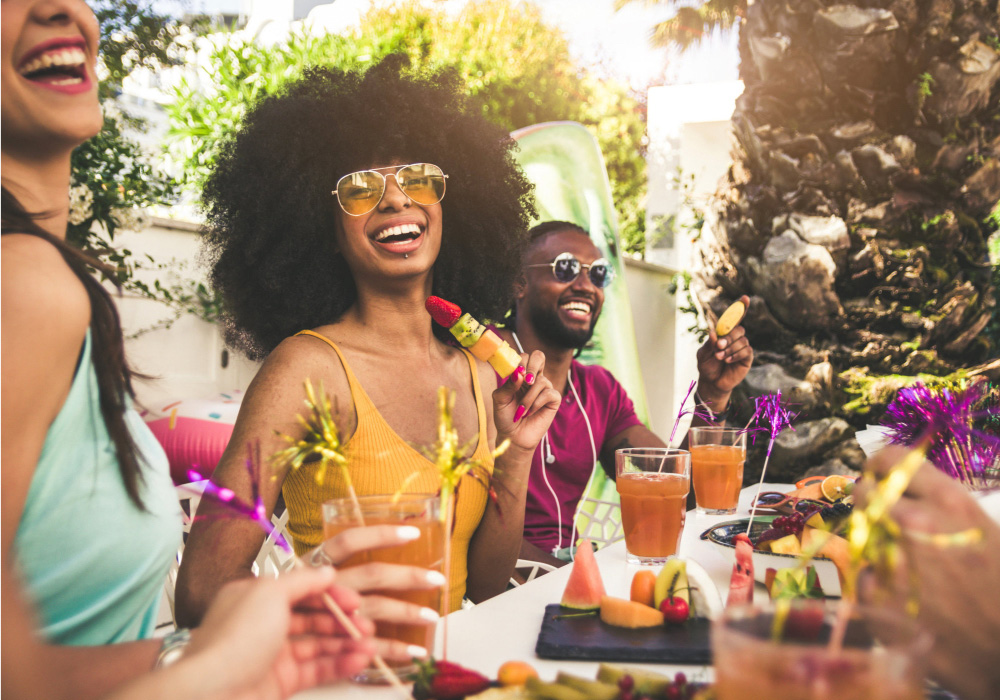On the fifth anniversary of George Floyd’s murder and the threshold of summer—a season when parks, sidewalks, and public transit hum with life—Jay Pitter Placemaking has released a groundbreaking survey report that brings Black voices to the forefront of how public space is experienced, challenged, and reimagined. Black people, like everyone else, deserve joy, safety, and a sense of belonging in public spaces. The landmark survey reveals what that truly looks like—through data, history, and voice.
“Like everyone else, Black people want to belly laugh in public”
This deceptively simple truth headlines the BEING BLACK IN PUBLIC SURVEY report—a sweeping, deeply human exploration of what it means to move through public space while Black in Canada and the United States.
The report, drawn from over 600 Black respondents across 100+ cities, amplifies more than 18,000 data points and over 50,000 words of lived experience. What emerges is both disturbing and illuminating: public spaces often fail to deliver the safety, freedom, and dignity that should be available to everyone. Yet, the report is not just a ledger of harm. It is also a vivid tapestry of joy, aspiration, and the everyday beauty of Black life.
The report goes far beyond the expected discussions of policing and surveillance. Instead, it captures a much broader, more textured portrait of what it means to be Black in public in North America today. Compiling over 18,000 data points and 50,000 words of testimony from more than 600 Black-identified individuals in over 100 Canadian and U.S. cities, this survey highlights a fundamental truth: Black people want what everyone else does in public space—to feel safe, to be themselves, to express joy, and to belong.
But the nuances of that desire—rooted in both historical trauma and contemporary barriers—reveal just how often public spaces fall short of that promise.
Understanding the research: A grounded and human-centred approach
Before the survey launched, Jay Pitter and her team conducted extensive pre-research, gathering more than 300 data points across eight public space categories. These included transit, green spaces, policing, homelessness, and environmental risks. This rigorous effort ensured that Black respondents’ lived experiences were validated not just by personal narrative, but also by data often scattered across disparate academic silos.
Unlike other studies that focus solely on institutionalized violence, this report is trauma-informed, intersectional, and asset-based. It invited Black participants—including 2SLGBTQ+ and disabled individuals—to share not only harm, but also hope. The result is a report that strikes a balance between vulnerability and vision.
What Black people need in public spaces: 7 core findings
Each of the seven themes in the report is framed affirmatively, centred on aspiration rather than deficit. This narrative shift is crucial for transitioning from performative allyship to tangible change.
1. Black people want to freely belly laugh in public
Laughter surfaced in every question of the survey—not just as a simple act of joy, but as a profound statement of freedom. Respondents recalled being silenced for laughing too loudly or targeted for expressing themselves playfully. The legacy of “laughing barrels,” where enslaved people had to muffle their joy to avoid punishment, still echoes today.
“Let us be loud, let us laugh and sing and make music—let us play.”
2. Black people want to feel safe in public
Safety is about more than the absence of violence—it’s about the presence of ease. Libraries, community gardens, and museums ranked as the safest spaces. Buses, sidewalks, and malls were least safe. Many respondents altered their dress, speech, and behaviour to feel less threatening, and nearly 60% had skipped an event entirely due to safety concerns.
3. Black people want mental wellness and peace in public
Participants spoke of longing to walk through a park without being on guard, or to relax without hypervigilance. Some described how small acts of kindness—sharing eclipse glasses, a stranger’s smile—had the power to uplift their mental health. But the toll of constant scrutiny lingers.
“The challenge to my mental health is never knowing when the next negative experience is going to happen.”
4. Black people want to express their cultural swagger and perspectives
Respondents longed to wear bright clothes, natural hairstyles, and cultural expressions without fear. Many code-switched or modified their appearance to avoid judgment or harm.
“To be able to wear the bold designs of Black creators without side-eyes... to laugh, move, and play as an adult Black woman.”
5. Black people would like a healthy level of acknowledgement
From being followed in stores to being excluded from eye contact or basic greetings, many respondents described feeling either hypervisible or invisible. But they also described moments of belonging—when someone said “good morning,” offered directions, or greeted their children with warmth.
“Simple gestures like a smile, greeting, and invitation to share space significantly increased my sense of belonging.”
6. Black people want to access more opportunities in public
Public space is not just for leisure—it’s a gateway to education, networking, and civic life. Yet 37% of respondents said they had missed out on opportunities due to discomfort or fear in public. These included not applying for jobs, skipping community meetings, or avoiding transit routes.
“I wanted to attend an event but decided not to go because I knew I’d be the only Black woman—and I didn’t want to be corrected mid-sentence or ignored.”
7. Black people want belonging, joy, and safety built into policy and design
Respondents were clear: they want thoughtful, inclusive design. That includes murals honouring Black culture, clean washrooms, safe lighting, seating for elders, and policies that center care rather than control. They advocated for their communities not just to be consulted, but to lead in shaping the spaces.
“We cannot be a meaningful part of something we did not design.”
From data to action: Turning insight into impact
The report goes beyond documentation. Through a collaboration with York University and Perkins&Will, students transformed survey findings into real-world design interventions. From trail lighting in Ajax to Afrofuturist signage in Toronto’s Jane and Finch, these ideas show how public policy, design, and engagement can create truly inclusive spaces.
Their proposals are tangible, hopeful blueprints rooted in community voice and professional expertise—a rare and necessary fusion.
A concluding reflection: Joy as a civic right
Jay Pitter’s conclusion is clear: the findings in this survey are not radical. Everyone wants clean parks, safe streets, and the chance to enjoy life. What’s radical is that Black people still have to ask for these things, still have to share stories of discrimination just to be seen, heard, and protected.
And yet, the report is not a litany of grievances—it is a testament to vision. Black people do not just survive public spaces; they shape, enrich, and redefine them. From laughter on sidewalks to pop-up play streets, from trail murals to food gardens, the vision is clear: public space should be a place where joy is not a rebellion, but a birthright.
Read the full report here.



